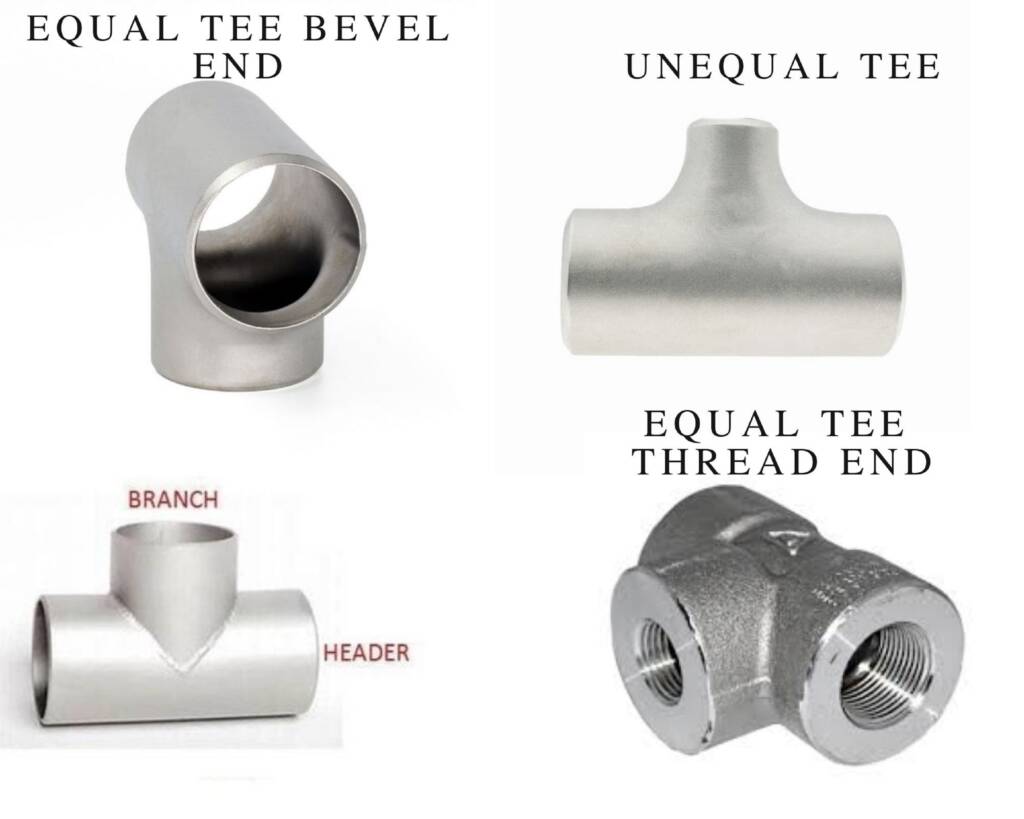What is a tee in pipe fitting?
Pipe Tee is a most frequently used pipe fitting or connector nowadays. It functions the same as olets that means it is used to take a branch connection for linear pipeline. As the name TEE represents, the shape is T-shaped with two outlets, at 90° to the connection to the main line. It is a short pipe piece with an integrated outlet. This is used to connect and take taping with a pipe at a right angle with the linear line. These can be fabricated with various materials such as (Stainless steel, Carbon steel, Cast iron, Nickel, Aluminum, Copper, Brass, Bronze, Plastic, Rubber, Polypropylene etc) and available in a variety of sizes and finishes (Galvanized, Nickel plated, Black cast steel, White coating, Gold finish electroplated, etc) that can be selected as per end user requirement. Pipe tees are mostly used in pipeline networks to transport two-phase fluid mixtures, and this can also be used instead of Olets.
General construction of TEEs is three sides of openings in pipe tees, two openings are leaner to each other, and another one is at 90 degree and in some special cases it will be changed as per user requirement. In the straight pipe tees which have the same size openings of all sides called (Equal Tee) or may be Reducing means that (one opening of different size and two openings of the same size). There are sanitary pipe tees (these kind of pipe tees have a curved branch which is designed for a clean out plug) which are used in waste lines. The benefits of this is, used to prevent obstruction of waste. And there is also a variety available that is cross pipe tee, It has four equal sized female openings. But this is not used for high pressure systems and not frequently as well, mostly that is available in threaded opening and opening is used in conjunction with a threaded plug for a clean-out opening on a drain pipe. ASME standards for Tees design will be ASME/ANSI B16.9 or ASME/ANSI B16.11 and constructed by forging or casting.
Applications of pipe tees:
A variety of applications of Pipe Tees mostly used in industrial applications (Chemical processing pipeline, Petroleum, Gas compression unit, Pulp/paper, Refinery, Textile, Waste treatment, fluid power systems, Marine Utilities/power generation, Industrial equipment, Automotive).
How does a tee fitting work?
This is a static part of the piping system, used only for connecting two, three, different pipe lines at a single location; these all pipes which need to connect through Tee may be the same in diameter, schedule/ pressure class, or might be changed according to user requirements. The main work of Tees is to distribute the services fluids in different direction angles.
How many types of tees are there?
Straight Tees, Reducing Tees, Barred Tees, Wye Tee or Lateral, and Cross.
Further Tees are classified depending on end connection type these are as follows. Socket weld end, Threaded end connection type, Flanged end connection type and Butt weld end connection type, plan end and bevel end.
Why are equal tees used?
Equal Tees are used to connect pipes if all openings are equal in diameter but branch connection will be any angle like 90, 45 degree or any others. And this is used if all branched pipe has the same diameter required except the same design and dimension will be followed to fabricate.
Why are unequal tees used?
The unequal Tees are used to connect pipes if all branched pipes are unequal in diameter but branch connection will be any angle like 90, 45 degree or any others or where one or two of the tee outlets will be smaller diameter than the other. But the same design and dimension will be followed to fabricate as equal Tees.
What’s the branch of a tee?
The Branch of Tees means that take taping from pipeline to Tees at any angle like 90, 45 degrees. That will be the same size or reducing type (means that branch pipe diameter size is different as existing pipeline).
What is the difference between a sanitary tee and a regular tee?
Sanitary tees are the same in t-shaped sanitary pipe fittings used in the branch pipe of the main pipeline and this connects a branch line to a vertical drain line or vent line. Sanitary tees can be made with an existing pipeline diameter or different diameters to connect to other pipes or valves with different fitting sizes. Sanitary Tees are available in many different capacities, classes, shapes and sizes, but all of them only have two main types of sanitary tees which are most frequently used in industries and plumbing.
How To Select Pipe Tee?
Selection of pipe Tee
There are many parameters for selecting an appropriate pipe Tees, some of the important are given below.
- Choose DN (nominal diameter) and schedule 1st pipe end like (100NB X 100NB X 25NB).
- Types of Tees required (Equal type means like 100NB X 100NB X 100NB, or Unequal type like 100NB X 100NB X 25NB).
- Choose DN (nominal diameter) and schedule for 2nd pipe end (small pipe bore)
- Distance from one pipe end to another pipe end (length of the Tee).
- Select the dimensions standard for Tees ASME B16.9, MSS SP-43, ANSI B16.5.
- Select the design standard for the Tees ASTM A234 GRADE WPB, ASTM A105, ASTM F1545.
- Process of Tees fitting made (Seamless or ERW, Electric resistance welding).
- Select the (MOC) materials of construction for your fitting, like mild steel (MS), stainless steel (SS), carbon steel, etc.
- Select Class or Pressure rating or Schedule, according to your piping design.
- What type of end connection is required, Plane end (PE), Bevel end, Flange end.
- Types of weld required Socket weld or Butt weld.
- Corrosion resistance
- Durability

